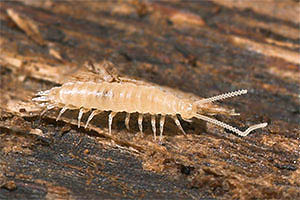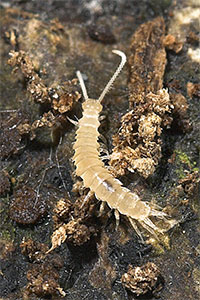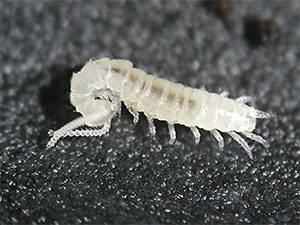|
Symphyla

Symphyla, native beech forest, New Zealand.
Common name: symphylids, garden centipedes.
Scientific name: phylum Arthropoda, class Symphyla. From “syn”, with, and "phyla”, types, reflecting the affinity of the group with both myriapods and insects.
Description
The Symphyla are small (0.2-1.2 cm in length), creamy-white, blind soil myriapods, very common in many soil habitats. Their soft, segmented body is elongated, consists of 15-24 segments, and ends with two pointed cerci. The segments are covered dorsally with overlapping dorsal plates.
With their 12 pairs of relatively short legs, symphilids resemble small white centipedes, and the first Symphyla was actually described as a centipede in 1763. It was not until 100 years later that these animals were recognized as a separate class within Arthropoda. Symphyla can be easily distinguished from centipedes as they lack the forcipules (poison claws). Instead, the symphilid head has chewing mouthparts. The head bears a pair of long antennae; the eyes are absent.
Notes on biology
Most Symphyla are omnivorous, and feed on soft tissues of plants and animals, decaying organic materials, and soil microorganisms. Predation on soil nematodes has been observed in Symphylella (Walter et al., 1989). Some species are predominantly herbivorous, feeding on plant roots and the root hairs, and can become serious pests of agricultural crops, as they feed on the roots of a wide range of crops.

Symphyla, New Zealand.
Symphyla are extremely voracious and will consume organic matter at earlier stages of decay than will many other soil invertebrates (Edwards, 1990). In soil ecosystems, Symphyla participate in breaking down organic matter and redistributing the nutrients through the soil profile.
The sexes are separate. The male deposits stalked droplets of sperm (spermatophores) on the substrate and abandons them. The female picks up the spermatophore and uses it to fertilize the eggs. Eggs are laid in small clusters, and guarded by the female. Newborn Symphyla have six pairs of legs, and grow through a series of moults, adding more body segments and pairs of legs as they develop. There are seven juvenile stages, and the large number of moults, until the adult stage is reached. The development to maturity takes about a year. Moulting continues throughout their life, and adult Symphyla can live for several years, undergoing more than 50 moults.
Where to find them?

Symphyla, New Zealand.
Symphyla are extremely common in New Zealand. They can be found in a wide variety of habitats, usually in forests, in soil, litter, decaying wood and similar microhabitats, but also in the gardens, greenhouses, and farmlands, often quite deeply in soil. There are several cave-dwelling species. These fast-running, white myriapods are abundant and easy to notice, but difficult to collect by hand, as they are small and very fragile. I have often found Symphyla in Berlese extractions; alternatively, the reader can consult Edwards (1990) for the best collection techniques. Symphyla can be kept in the culture in the same way as Collembola.
Distribution and conservation
Around 160 species of Symphyla are recognized
worldwide, with only two families - Scutigerellidae and Scolopendrellidae.
Fifteen genera are known, and many genera are found worldwide.
The most common genera are Scutigerella, Hanseniella,
and Symphyella. Numerous species have been described
from different parts of the world – for example, 27
species comprise described Australian fauna; 26 species are
known from the US. Fourteen species of Symphyla are known
from New Zealand – 2 species of Symphyella,
and 12 species of Hanseniella. Not much is known
about the biology or ecological importance of New Zealand
native Symphyla. No up-to-date taxonomic treatment exist.
Symphyla are not protected in New Zealand.
The garden centipede Scutigerella immaculata, a world-wide
distributed agricultural pest of vegetable crops, is listed
as a regulated pest species by the New Zealand Ministry of
Agriculture and Forestry. Scutigerella immaculata
has been recently found in Australia (Halliday, 2004).
Included images:
- Unidentified species - Hinewai Reserve, Banks Penninsula, MC, South Island
- Unidentified species - Kawhatau Base, RI, North Island
Further information on New Zealand
Symphyla:
Adam, M.O., Burtel, J. 1956. A contribution
to the study of New Zealand Symphyla. Records of the Canterbury
Museum 7(2): 61-88.
Edwards, C.A. 1959. Keys to the genera
of the Symphyla. Journal of the Linnean Society of London
Zoology 44, p.164-169.
Edwards, C.A. Symphyla. In: Dindal D.L.
(ed.). Soil Biology Guide. J. Wiley & Sons, New York,
p. 891-910.
Halliday, R. B. 2004. Confirmation of the
presence of Scutigerella immaculata (Newport) in Australia
(Symphyla: Scutigerellidae). Australian Journal of Entomology
43, 43-45.
Scheller, U. 1961. A review of the Australian
Symphyla (Myriapoda). Australian Journal of Zoology 9, p.
140-171.
Ryan, C.L.J. 1974. Symphilids - a new pest in orchards and nurseries. Orchardist NZ 47(5), p. 158-161.
Walter, D.E., Moore, J.C., Loring, S. 1989.
Symphylella sp. (Symphyla: Scolopendrellidae) predators
of arthropods and nematodes in grassland soils. Pedobiologia
33, p. 113-116.
Symphyla Resources on the Web
Tasmanian
Symphyla, maintained by B. Mesibov, Queen Victoria Museum
and Art Gallery, includes general information on Symphyla,
their description, distribution and identification. Includes
bibliography.
Australian
Faunal Directory - Checklist for Symphyla, Department
of Environment and Heritage, checklist of Australian fauna,
including world distribution, bibliography, and some information
on ecology.
World
Bibliography on Subterranean Myriapoda - Symphyla, by
B. Lebreton.
The
Tree of Life - Symphyla, gives phylogenetic relationships
within the class, and lists the references and websites.
Pauropods
and Symphylids, by D. Kendall, Kendall Bioresearch Services,
a brief description and drawing of Symphyla.
|